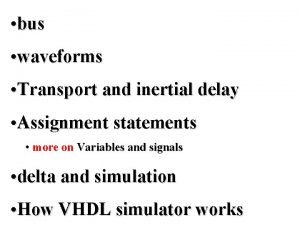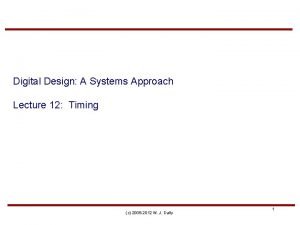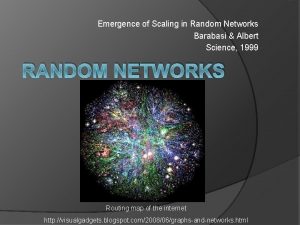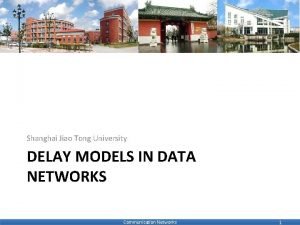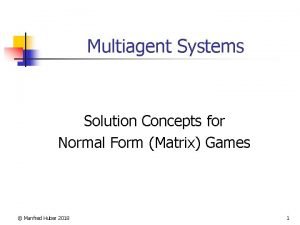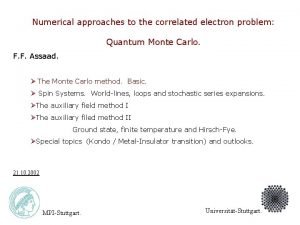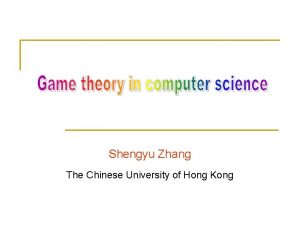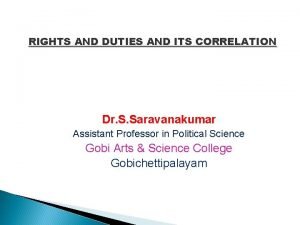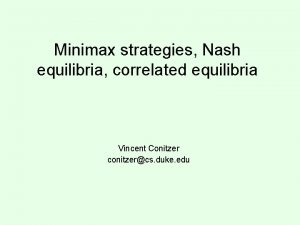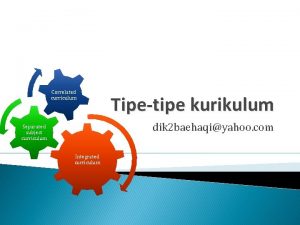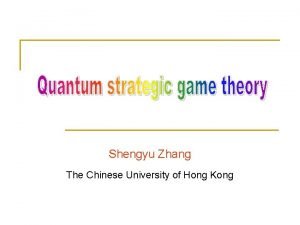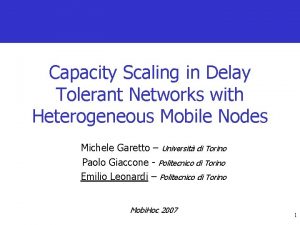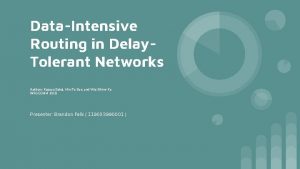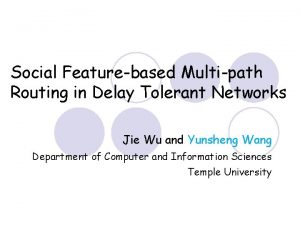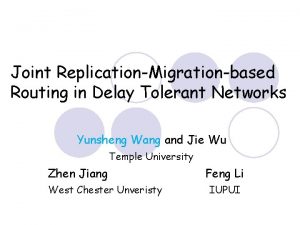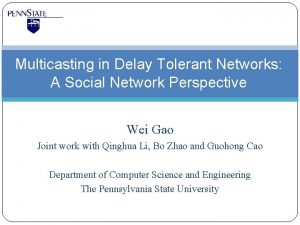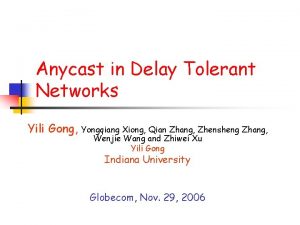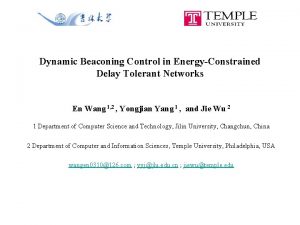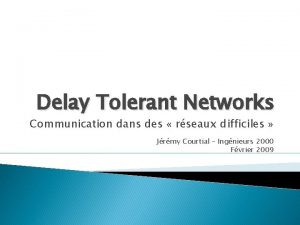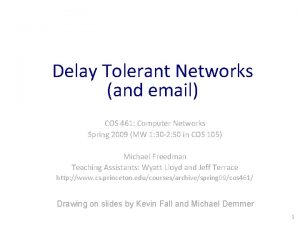Scaling Properties of Delay Tolerant Networks with Correlated













- Slides: 13

Scaling Properties of Delay Tolerant Networks with Correlated Motion Patterns Uichin Lee, Bell Labs/Alcatel-Lucent Soon Y. Oh, Mario Gerla (UCLA) Kang-Won Lee (IBM T. J. Watson Research)

Key DTN Metric: Pair-wise Inter-contact Time Key metric for measuring end-to-end delay Pair-wise inter-contact time: interval between two contact points T 2 T 1 T 3 Contact points between two nodes: i and j Tic(1) Tic(2) T 1 Tic(3) T 2 T 3 time Tic(n): pair-wise inter-contact time Inter-contact distribution: § Exponential : bounded delay, but not realistic? § Power-law : may cause infinite delay, but more realistic? 2 Alcatel-Lucent

Two-phase Inter-contact Time Power Law Head Exponential Tail Log-log plot Time (days) Power Law Head Exponential Tail Log-log plot Time (min) Levy walk based mobility Lee et al. Infocom’ 08/09 Log-log plot Karagiannis et al. , Mobi. Com’ 07 3 Inter-contact time CCDF Two-phase distribution: power-law head and exponential tail • Association times w/ AP (UCSD) or cell tower (MIT cell) • Direct contact traces: Infocom, cambridge (imotes), MIT-bt Alcatel-Lucent

Two-phase Inter-contact Time Why two-phase distribution? One possible cause: § Flight distance of each random trip (within a finite area) [Cai 08] § The shorter the flight distance, the higher the motion correlation in local area, resulting heavier power-law head Power-law head while in local area vs. exponential tail for future encounters in local area Examples motion Frequent correlation: Goal: ofunderstanding impacts of correlated motion §patterns Manhattanon sightseers: In Time Square, sightseers tend to bump into throughput/delay/buffer scaling properties each other; and then depart for other sights Levy flight of human walks [Rhee 08]: short flights + occasional long flights § Vehicular mobility: constrained by road traffic (+traffic jam) High correlation among vehicles in close proximity After leaving locality, vehicles meet like “ships in the night” Local area *Cai 08: Han Cai and Do Young Eun, Toward Stochastic Anatomy of Inter-meeting Time Distribution under General Mobility Models, Mobi. Hoc’ 08 *Rhee 08: Injong Rhee, Minsu Shin, Seongik Hong, Kyunghan Lee and Song Chong, On the Levy-walk Nature of Human Mobility, INFOCOM’ 08 4 Alcatel-Lucent

DTN Model: Inter-contact rate + flight distance Inter-contact rate: λ ~ speed (v)*radio range (r) [Groenevelt, Perf’ 05] Random waypoint/direction (exp inter-contact time) Flight distance (motion correlation): Ranging from radio radius Ω(r) to network width O(1) Invariance property: avg inter-contact time does not depend on the degree of correlation in the mobility patterns [Cai and Eun, Mobihoc’ 08] 1 1 flight distance = Θ(r) flight distance = Θ(1) 1 radio range=Θ(r) 1 Varying flight distance Random walk 5 radio range=Θ(r) Random direction Alcatel-Lucent

2 -Hop Relay: DTN Routing Each source has a random destination (n source-destination pairs) 2 -hop relay protocol: 1. Source sends a packet to a relay node 2. Relay node delivers a packet to the corresponding receiver 2 -hop Relay by Grossglauser and Tse Source to Relay to Dest Source Relay Destination 6 Alcatel-Lucent

2 -Hop Relay: Throughput Analysis Intuition: avg throughput is determined by aggregate meeting rate (src relay and relay dest) Two-hop relay per node throughput : Θ(nλ) § Aggregate meeting rate at a destination: nλ § Grossglauser and Tse’s results: Θ(nλ)=Θ(1) when λ = 1/n (i. e. , speed 1/√n, radio range 1/√n) Motion correlation (w/ flight len [O(r), O(1)]) still preserves meeting rate Source Destination Food (=source) Source to Relay 7 Ants (=relays) Relay to Destination Alcatel-Lucent

2 -Hop Relay: Delay Analysis Source to relay node (Dsr), and then relay to dest (Drd) § Dsr = avg. inter-any-contact time to a random relay § Drd = avg. residual inter-contact time (relay dest) Mean residual inter-contact time (Drd) = E[T 2] / 2 E[T] >> T is a random variable for inter-contact time Random Direction (RD): E[T 2] = O(1/λ 2) Drd=O(1/λ) 2) D source paradox tends Inspection Random Walk (RW): E[T 2] =(length O(logn*1/λbias): rd=O(logn/λ) sample a D(n) longer inter-contact Averageto 2 -Hop Delay: = [O(1/λ), O(logn/λ)]interval between relay and dest nodes Source to Relay § As flight distance increases, average delay decreases monotonically Relay to Dest Inter-contact history: Relay Dest Source Relay Destination 8 Src Relay Alcatel-Lucent Time

2 -Hop Relay: Buffer Requirement Little’s law: buffer = (rate) x (delay) Required buffer space per node: B = [Θ(n), Θ(nlogn)] § Rate*delay = Θ(nλ)* [1/λ, logn/λ] = [Θ(n), Θ(nlogn)] Recall: random direction (1/λ) and random walk (logn/λ) § Motion correlation requires more buffer space Θ(n) srcs Θ(n) dests § Correlation increases burstiness of relay traffic Rate: Θ(nλ) S 1 S 2 D 1 D 2 R Impact of limited buffer. S 3 space on throughput D 3 § Limited buffer of Θ(K) at each relay node is fairly shared by all sources Relay § Relay node carries a packet to a certain dest with prob. K/B Delay: [Θ(1/λ), Θ(logn/λ)] § Throughput per source = Θ(nλ*K/B) 9 Alcatel-Lucent

Simulation: Throughput Degree of correlation via average flight distance L § L=250 m high correlation power law head + exponential tail § L=1000 m low correlation almost exponential L=250 m Exp L=1000 m L=250 m log-linear Log-log Throughput per node (kbps) Inter-contact time CCDF Throughput is independent of the degree of correlations CCDF of inter-contact time (20 m/s) 10 5000 m*5000 m area # of nodes <=100 Radio range = 250 m 802. 11 w/ 2 Mbps Average throughput per node as a function of # nodes Alcatel-Lucent

Simulation: Inter-any-contact Time Inter-any(k)-contact time: inter-contact time to any of k nodes Invariance property: avg inter-contact time is independent of correlation Residual inter-contact time: source probes a random point of the intermeeting times between relay and destination 20 m/s L=250 m 20 m/s L=1000 m 20 m/s 30 m/s L=250 m 30 m/s L=1000 m 30 m/s Number of relay nodes (k) Average Inter-contact time 11 Number of relay nodes (k) Average residual inter-contact time Alcatel-Lucent

Simulation: Buffer Utilization Burstiness of relay traffic increases with the degree of correlation Relay node’s contact history Time S S D D D S S D N=3 N=2 # consecutive encounters (N) S Source D Destination L=250 L=1000 P(N<=X) Cumulative dist of # consecutive encounters Number of consecutive encounters (N) 12 Alcatel-Lucent

Conclusion Impact of correlated motion patterns on DTN scaling properties DTN model: inter-contact rate + motion correlation via flight distance Flight distance of Ω(r); i. e. , min travel distance ~ one’s radio range Considered mobility ranges from Random Walk to Random Direction Main results: Throughput is independent of motion correlation Delay monotonically increases with the degree of correlation Buffer requirement also increases with the degree of correlation Correlation increases burstiness of relay traffic Future work: Applying results to DTN multicast scenarios Scaling properties of inter-domain DTN scenarios 13 Alcatel-Lucent
 Assignment statement
Assignment statement Plc timers
Plc timers Propagation delay and contamination delay
Propagation delay and contamination delay Emergence of scaling in random networks
Emergence of scaling in random networks Ccna 3 scaling networks ppt
Ccna 3 scaling networks ppt Delay models in data networks
Delay models in data networks Correlated equilibrium
Correlated equilibrium The future of the correlated electron problem
The future of the correlated electron problem Correlated equilibrium
Correlated equilibrium Rights and duties are correlated
Rights and duties are correlated Correlated equilibrium
Correlated equilibrium Correlated curriculum
Correlated curriculum Correlated group design
Correlated group design Correlated equilibrium
Correlated equilibrium
